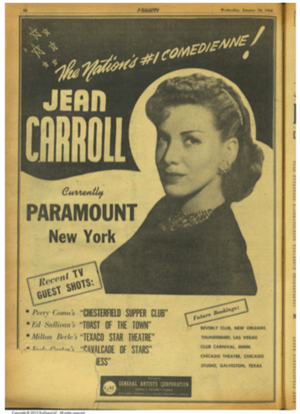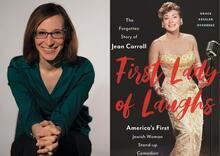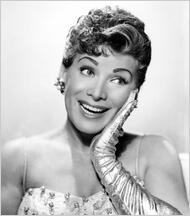Jean Carroll
Born Sadie Zeigman, Jean Carroll was the first Jewish woman stand-up comedian. After getting her start in the last gasp of Vaudeville in the 1920s, she appeared at every major production house in New York City and many across the United States and London throughout the 1950s. She was featured on The Ed Sullivan Show 29 times and briefly had her own sitcom on ABC. Jean Carroll was the lone woman in the first cohort of comedians—such as Milton Berle and Henny Youngman—who were developing the genre now known as stand-up comedy. With her sophisticated and savvy persona, Carroll embodied a different model of Jewish femininity than the nagging stereotypes presented by her male colleagues.
Early Life: From Paris to Vaudeville
The person who would become “Jean Carroll” was born to the young Jews of European origin and their descendants, including most of North and South American Jewry.Ashkenazi couple Anna and Max Zeigman. Anna was a Russo-Polish orphan and Max was an escaped Russian soldier imprisoned in Paris for desertion. In Paris, Anna gave birth to Jean’s two older sisters, Rachel and Mary, and then, on January 7, 1911, to Jean, who was officially called Celine but affectionately nick-named Sadie. The family immigrated to the United States in 1912, moving around New England before settling in the Bronx, in New York City.
The family grew, with Max and Anna giving birth to two more children. However, Carroll’s home life was plagued by her father’s struggles with alcoholism and by his physical abuse of her mother. According to Carroll, when she was eight years old she witnessed her father attack her mother and resolved that she would save her mother from this situation and never herself be beholden to a man.
Carroll began using what she learned at dance and singing classes to earn money at the many amateur houses that peppered urban areas. These venues were the lowest rung of the New York entertainment industry, but they offered cash prizes for talent competitions. Carroll recounts that anti-Semitic pressure prompted her name-change to “Jean Carroll” as she was hired to be the “lemon act”—meaning that she was given money under the table for pretending to be a terrible performer for the crowd’s entertainment.
By the time she was eleven or twelve years old, Carroll had earned the equivalent of a high-school diploma. Through her earnings from performing and a day-job at a real estate office on East Tremont Avenue, she began earning enough money to support her family of five. Explaining that “In a Jewish family, if you brought home the pay, you ruled supreme,”' Carroll later claimed that she used her position as breadwinner to force her father to move out of the house. Around the same time, the preteen got her start touring the Variety circuit, a nation-wide network of theaters that presented family-friendly shows like musical acts and comedy sketches.
After singing and dancing on the Variety circuit for several years, Carroll was part of a number of “Man/Woman Acts,” duos in which a man and a woman exchanged comic banter in between duets and dance numbers. When working on the act “Marty May, Friend of Thousands, Annoyed by Jean Carroll,” with Marty May, she broke precedent by demanding equal pay for equal work. She ultimately left May to form a Man/Woman Act with Buddy Howe, whom she eventually married.
In Buddy Howe, Carroll found not only a new performing partner and a spouse, but also a champion who appreciated and encouraged her talent as a comedy writer. Howe urged Carroll to write the duo’s material. They became extremely successful, playing theaters across the United States and England. Like many entertainers in the 1940s, they performed for the troops with the United Service Organization. In 1943, however, Howe was called to service. Rather than dissolving the act, he encouraged Carroll to continue it on her own. Even after he returned from military service, Howe urged his wife to continue performing solo. He assumed the role of her manager, while she became a star. Even after their daughter Helen was born in 1945, Howe urged Carroll to keep performing while he worked as an agent.
A Stand-Up Comedienne
Jean Carroll’s transformation from “Double” to “Single” coincided with a larger shift in the state of the entertainment industry. The Variety and Vaudeville circuits, with their constellation of many small theaters, had given way to larger production houses. Big-time venues and night-clubs like the Copacabana in New York, Miami’s Five-o-Clock Club, and the Catskill Mountains’ Grossinger’s Hotel demanded routines with more material.
Carroll delivered on those demands, crafting a routine out of parody songs, impressions, one-woman comic sketches, and a seemingly endless supply of one-liners. Early in her career, she entertained nightclub audiences with Yiddish-inflected parodies like “When I Began with Levine” (riffing on “Begin the Beguine”). But these were relatively short-lived. Unlike contemporaries such as Myron Cohen or Gertrude Berg, she made a point of not leaning heavily on dialects or broad ethnic humor. And unlike contemporaries such as Henny Youngman or Sam Levenson, she did not build a routine on misogyny and negative stereotypes of Jewish wives and mothers.
Caroll’s routines hewed close to “universal” (really, heterosexual, white, upper-middle-class) American experiences. In one of her most famous bits, she did a one-woman recreation of an afternoon at the horse races, from the starting trumpet to the mile-a-minute announcer. When telling a story of buying a dress or a fur coat, she gave scathing imitations of the shifty furrier or the pushy salesgirl. And she spoke with unprecedented candor on the subjects of marriage and motherhood, occasionally shocking mid-century sensibilities with cutting jokes about her miserly husband and “rotten kid.”
Critics were simultaneously thrilled and bemused to find a woman in the “Fraternity” of comedians experimenting with the budding form of stand-up comedy. Those who weren’t ejaculating proclamations of shock at her ability to be both funny and traditionally feminine were busy labeling her the “female version” of every male comic from Milton Berle to Groucho Marx.
But it was more than just her gender that set Jean Carroll apart. It was her overall style of performance—an intimate, conversational delivery that made crowds feel that they were friends or confidantes rather than audience members. Her comedy relied on authenticity, in terms of both her persona and her material.
Career Highlights
Comedian Jean Carroll performing her racetrack routine on the Ed Sullivan Show, January 30, 1949.
The entertainment media landscape shifted again under Carroll’s feet, as live performance gave way to television in the late 1940s and 1950’s. After building an audience in nightclubs and performance houses around the country, Carroll was invited to make her debut on The Ed Sullivan Show—then called Toast of the Town—in 1948. Her performance of the Racetrack Routine was so successful that Sullivan asked her to return over twenty more times, even signing an exclusive agreement that limited her appearances on competing shows such as The Gary Moore Show.
Comedian Jean Carroll performing about going to buy a dress and ending up owning the dress store, on the Ed Sullivan Show, January 17, 1960.
In addition to her appearances on variety shows like Sullivan, Carroll pursued her own television show. After several false starts and rapid turnover, The Jean Carroll Show, also called Take It From Me, aired on ABC in 1953. The show attempted to mix Carroll’s stand-up act with a domestic sitcom in which she portrayed a beleaguered housewife. While Carroll’s performance was critically praised, the writing was mostly panned. The show failed to find a sponsor and was taken off the air by January of 1954.
In spite of the failure of her sitcom, Carroll was mostly undeterred. She doubled down on her Sullivan spots, making nearly twenty appearances between 1954 and 1966. She also released a hit comedy album, Girl in a Hot Steam Bath (1960), with Columbia records.
Legacy
By the time Jean Carroll retired in the mid-1970s, she had spent over four decades in the ever-changing comedy scene. She had set a precedent for women in the male-dominated field of stand-up comedy. And she had established a style of authenticity and confidentiality that would come to define stand-up as a genre. Moreover, she had inspired women like Lily Tomlin, Joan Rivers, and Joy Behar, who grew up watching her on The Ed Sullivan Show. She was even a reference point for actress Rachel Brosnahan as she prepared for her lead role on the Amazon sitcom The Marvelous Mrs. Maisel. Unlike so many of her predecessors, Jean Carroll modelled a kind of Jewish immigrant woman who was both opinionated and assimilated, funny and glamorous.
But a darker element of Carroll’s legacy is on view in the personal scrapbooks that she left behind after she died on January 1, 2010, at the age of 98. Alongside the press clippings charting her professional successes are several feature articles and interviews in which she expressed distress over wanting to spend more time with her husband and child. This very public display of anxiety is a testament to the challenges of balancing a demanding career and fulfilling the expectations of motherhood—especially in the 1950s. Although a great deal has changed since then, these challenges remain a relevant and pressing obstacle to women stand-up comedians.
Selected Works by Jean Carroll
Girl in a Hot Steam Bath. Sound recording. New York, NY: Columbia, 1960.
Jean Carroll Interview Transcripts. Interview by Stephen Silverman, November 6, 2006. Stephen Silverman Personal Collection, New York City, New York.
Jean Carroll Scrapbook. Personal Collection of Susan Chatzky.
Bob. “Night Club Reviews: Sahara, Las Yegas.” Variety, September 29, 1954.
Gould, Jack. “Television in Review.” New York Times. November 13, 1953. 1
Gaghan, Jerry. “Cross Town,” n.d. Page 29. Jean Carroll Scrapbook. Personal Collection of Susan Chatzky.
Gros. “Televison Review: TAKE IT FROM ME.” Variety, November 11, 1953.
Laurie, Joe. “Review-Preview: The ‘39 Going on 50’ Bracket.” Variety, July 16, 1952.
Levy. “Radio-Television: Chevalier Wows ’Em At Annual Radio-TV Correspondents Dinner.” Variety, April 2, 1958.
Lowe. “House Review: Capitol, Wash.” Variety, February 5, 1947.
Soloski, Alexis. “Did You Hear the One About the Housewife Who Walks Into a Comedy Club?” The New York Times, January 20, 2018, sec. Arts. https://www.nytimes.com/2017/11/21/arts/television/marvelous-mrs-maisel….
“The Ed Sullivan Show FT. Jean Carroll.” CBS, April 5, 1959. SOFA Entertainment.
“Toast of the Town,” January 16, 1949. SOFA Entertainment.
Tomlin, Lily. Interview by Stephen Silverman. Transcripts, November 6, 2006. 7-1--7-12. Stephen Silverman Personal Collection.
“Uncle Sam’s Callboard: Carroll & Howe Broken Up.” Variety, October 6, 1943.
“With Jean It’s the Family First, Show Biz Second,” n.d. Page 78. Jean Carroll Scrapbook. Personal Collection of Susan Chatzky.
Wollman, Jane. “First Lady of Laughs Fifty Years Ago, Jean Carroll Was America’s No. 1 Female Stand-Up Comic. But Comedy Wasn’t Always a Funny Business.” Sun-Sentinel (Fort Lauderdale, FL), June 16, 1991. Newsbank, Inc.
Wray, John. “Toast of the Town (Rudy Vallee, Nanette Fabray).” CBS, January 16, 1949. The Paley Center for Media.









